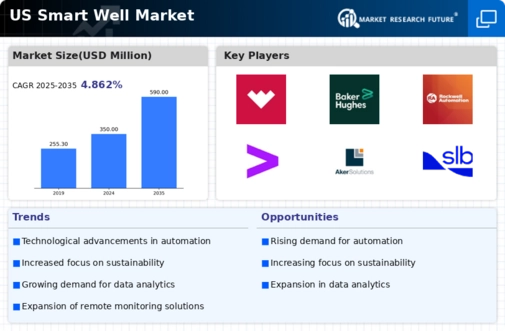Rising Energy Prices
The smart well market is significantly influenced by the fluctuations in energy prices. As crude oil and natural gas prices rise, operators are compelled to seek innovative solutions to enhance extraction efficiency and reduce operational costs. The current landscape indicates that energy prices have seen an increase of around 20% in the last year, prompting companies to invest in smart well technologies that can optimize resource management. These technologies enable real-time data analysis and predictive maintenance, which are crucial for maintaining profitability in a volatile market. Consequently, the smart well market is poised for growth as energy prices continue to drive the need for advanced extraction methods.
Advancements in Data Analytics
Advancements in data analytics are playing a crucial role in the evolution of the smart well market. The ability to analyze vast amounts of data generated from drilling and production activities allows operators to make informed decisions that enhance efficiency and productivity. The market for data analytics in the oil and gas sector is anticipated to grow by 18% annually, driven by the increasing need for predictive analytics and machine learning applications. These technologies enable operators to identify patterns and optimize well performance proactively. As data-driven decision-making becomes more prevalent, the smart well market is likely to expand, offering innovative solutions that leverage advanced analytics.
Increased Demand for Automation
The smart well market is experiencing a notable surge in demand for automation technologies. This trend is driven by the need for enhanced operational efficiency and reduced labor costs in the oil and gas sector. Automation solutions, such as remote monitoring and control systems, are becoming essential for optimizing well performance. According to recent data, the adoption of automated systems in the industry has increased by approximately 30% over the past few years. This shift not only improves productivity but also minimizes human error, thereby enhancing safety protocols. As companies strive to maximize output while minimizing costs, the smart well market is likely to benefit from this growing inclination towards automation.
Integration of IoT Technologies
The integration of Internet of Things (IoT) technologies is transforming the smart well market. IoT devices facilitate real-time data collection and analysis, allowing operators to monitor well conditions and performance remotely. This capability is particularly valuable in the US, where vast and often remote oil fields require efficient management. The market for IoT in the oil and gas sector is projected to grow at a CAGR of 25% over the next five years. By leveraging IoT solutions, companies can enhance decision-making processes, reduce downtime, and improve overall operational efficiency. As the industry increasingly embraces digital transformation, the smart well market is likely to expand in response to these technological advancements.
Focus on Environmental Compliance
The smart well market is increasingly shaped by the focus on environmental compliance and sustainability. Regulatory bodies are imposing stricter environmental standards, compelling operators to adopt technologies that minimize ecological impact. The implementation of smart well solutions can significantly reduce emissions and waste, aligning with the industry's shift towards greener practices. Recent statistics indicate that companies investing in environmentally friendly technologies have seen a 15% reduction in operational costs. This trend not only helps in meeting regulatory requirements but also enhances corporate reputation. As environmental concerns continue to gain prominence, the smart well market is expected to thrive as operators seek compliant and sustainable solutions.

















Leave a Comment